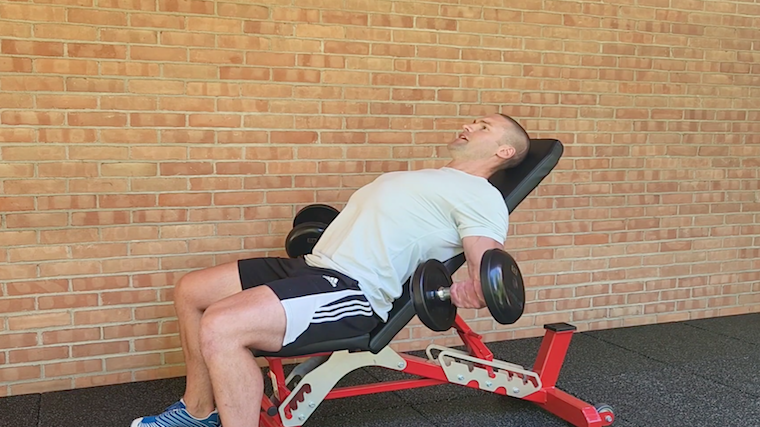The flexibility to build muscle in response to coaching is part of our physiology. It’s deeply encoded in our DNA and persists all through our lifespan. Which means, lifters of any age and expertise stage ought to be capable of add noticeable muscle to their frames.
Should you’re intentionally and dedicatedly hitting the health club within the hopes of including muscle mass, however nonetheless not seeing outcomes, it’s time to step again and assume. Which of those twelve widespread errors are sabotaging your beneficial properties?
Widespread Muscle-Constructing Errors
Failing To Plan
Past the plain must schedule time for the gym, many lifters fail to make progress towards muscle-building objectives as a result of their coaching is disorganized. Haphazard exercises would possibly burn some energy, stimulate a good pump, and ship a pleasant hit of “really feel good” neurotransmitters, however actual progress is made when your coaching is intentional and thought-out.
The Downside
By failing to plan your weekly coaching, you allow your exercises to likelihood. Some physique elements could obtain less-than-optimal coaching quantity (units and reps) whereas others are overworked.
In contrast to specialised hypertrophy applications that deliberately underload one space to allocate extra coaching to a lagging muscle group, unplanned coaching tends to be persistently inconsistent, leading to inferior beneficial properties throughout.
Coaching hundreds could go untracked, leading to failure to acknowledge main indicators of progress, akin to the power to carry out extra repetitions with a given weight or the power to elevate extra weight. You may additionally miss main indicators of accumulating fatigue and under-recovery, which could in any other case be addressed by program changes or a deload.
The Resolution
Lifters critical about constructing muscle should construction their coaching, and following an efficient training split is an efficient begin. Coaching splits assist lifters get organized and keep organized by assigning a spotlight to every exercise.
For instance, in a push/pull/legs break up, your first exercise of the week focuses on higher physique pushing actions, which might have a tendency to focus on chest, entrance delts (shoulders), and triceps. The second exercise hits higher physique pulling workout routines, akin to rows, pulldowns, and pull-ups, together with biceps and rear deltoid (shoulder) work. And, you guessed it, the third exercise is leg day.
As soon as every exercise has a spotlight, even when that focus is a full-body exercise, the specified weekly coaching quantity for every physique half might be allotted to every physique half. Applicable coaching quantity for constructing muscle is mentioned within the subsequent part, however in the event you’re not planning or monitoring your coaching quantity, you’ll by no means know whether or not you hit the goal.

When you’ve established your break up, you should plan and observe the specifics of every exercise. At a minimal, this could embody:
- Train choice
- Variety of units and goal repetition vary for every train
- Precise variety of units and repetitions carried out
- Weight used
Maintain data in your telephone (i.e. utilizing an app) or use a tried and true pen and pocket book.
Quantity Management
Resistance coaching quantity refers back to the quantity of labor completed in coaching. “Quantity load” consists of the variety of units, variety of repetitions, and cargo for every train carried out. (1) Quantity load is a key determinant of hypertrophy (muscle acquire). (2)
Weekly coaching quantity load, relatively than day by day quantity load, is a extra essential consider hypertrophy coaching. (3) That’s, whether or not every muscle group is educated as soon as, twice, or thrice per week, the suggestions under on applicable weekly coaching quantity nonetheless apply.
The Downside
Lifters run into hassle once they overshoot or undershoot efficient weekly resistance coaching quantity. Like many organic processes, the connection between weekly quantity and muscle acquire seems to comply with a two-tailed, bell-shaped curve — a “Goldilocks” state of affairs.
Carry out too little quantity and also you’ll fail to make progress and even backslide. Carry out an excessive amount of quantity and also you’ll run the chance of non-functional overreaching, or declining efficiency that solely rebounds to baseline after extended restoration. (4)
The Resolution
To keep away from lacking out on beneficial properties attributable to inadequate quantity or unsustainably excessive quantity, you first must have an concept of baseline coaching quantity. A easy method of calculating quantity is by totaling the variety of weekly units per main muscle group. (1)
In keeping with an professional consensus assertion on hypertrophy, 10 weekly units per main muscle group is an efficient minimal goal for educated people. As a normal rule, complete weekly units shouldn’t enhance greater than about 20% monthly of coaching. (5) Whereas higher will increase in quantity could also be sustained throughout deliberate “overreaching,” these short-term durations are usually adopted by a deload, or a pre-planned discount in coaching quantity and depth.

Don’t worry deloads. Throughout a deload, dramatic reductions in coaching quantity are widespread. Weekly quantity could also be diminished by roughly 50%. Lifters could also be cautious about aggressively decreasing quantity throughout deloads for worry of dropping muscle; nonetheless, analysis exhibits educated people keep power and dimension for not less than two weeks of no exercises. (6) Throughout a deload, you’re nonetheless lively and coaching.
Deloads are time-limited — usually one week or so. Deloads permit for restoration from exhausting cycles of coaching. Following a deload week, lifters are anecdotally extra delicate to coaching quantity, permitting them to “reset” weekly coaching quantity again towards reasonable quantity (e.g. 10 to 16 weekly units).
The query of top-end weekly quantity could also be of curiosity, too. Though some lifters could profit from increased coaching volumes, it’s probably not essential for many to push previous 20 or so weekly units per muscle group, particularly if different coaching variables are progressive over time.
Lack of Development
The identical units, reps, and weights that constructed your present physique is not going to construct your dream physique. It’s because our muscle tissues, like all organic programs, attain equilibrium (i.e. homeostasis) shortly if not supplied with progressive coaching stimuli.
The Downside
Knowledgeable by the tenets of the overall adaptation syndrome (GAS), which describes how residing organisms reply to stressors, non-progressive stimuli lead to an eventual plateau of organic responses. (7) For hypertrophy coaching, this implies non-progressive exercises will finally turn out to be non-productive exercises and also you’ll cease seeing muscle beneficial properties.
The Resolution
The best resolution to non-progressive coaching is to guarantee you might be both including quantity (units and/or reps) or load to your lifts frequently.
Though any respectable, ready-made program will already incorporate development, a easy methodology of development for constructing your individual program is to begin by figuring out a weight for every train that permits you to carry out quite a lot of repetitions towards the underside of your goal repetition vary for reasonable effort units.
For instance, a lifter wishing to program neutral-grip lat pulldowns within the eight to 12 repetition vary would possibly decide she is ready to use 165 kilos (75 kilograms) for 8 reps whereas having two or three repetitions left in reserve.

Now, every week, she will be able to both add one repetition per set or add 2.5% to five% extra weight — she will be able to both progress to 165 kilos for 9 or extra reps or 170 kilos for eight reps. She’s going to proceed so as to add repetitions or weight till she’s unable to stay throughout the goal repetition vary. Then it’s time to take a deload interval of roughly one week and restart.
Alternatively, in the event you really feel you aren’t prepared for a deload, merely modify your goal repetition vary to accommodate an extended interval of development (12 to fifteen repetitions, on this instance).
Quasi-Cardio Exercises
Working up a sweat and getting the guts pumping are options of many intense periods, and most lifters worth that sort of coaching. Supersets, which pair workout routines back-to-back thereby minimizing relaxation, are a mainstay of many of those intense exercises. (8)
However some lifters take “minimal relaxation” too far. If relaxation between units is restricted to the purpose the place exercise high quality or efficiency suffers, the exercise could fail to realize its final goal: constructing muscle.
The Downside
To be clear, the issue isn’t lack of relaxation between units, per se. It’s the ensuing lack of coaching quantity and/or depth that inevitably happens after not taking sufficient relaxation. (9)
Lowering relaxation durations will play up the cardiovascular problem of the exercise. Whereas cardio is superb for total well being, it isn’t the best sort of coaching for constructing muscle. Furthermore, “lifting gentle weights quick” or “lifting with minimal relaxation” is unlikely to be optimum cardio for many. Rhythmic or cyclical workout routines are typically extra appropriate (e.g. rowing machine, jogging, biking, swimming, and many others.).

“Frankensteining” a cardio-like, resistance coaching exercise is not going to permit sufficient restoration of the phosphagen and anaerobic alactic vitality programs which predominantly gas conventional resistance coaching. This leads to misplaced repetitions and/or necessitates use of decrease hundreds. Since quantity load drives hypertrophy, brief relaxation intervals finally result in inferior progress. (9)
The Resolution
Outdoors of very particular situations akin to supersets, guarantee you might be getting sufficient relaxation between units to keep up desired coaching quantity all through your hypertrophy exercise. Take a minimal of two minutes relaxation between units of multi-joint workout routines and 60 to 90 seconds between units of single-joint workout routines. (5)
Tip-Toeing Round Pressure
These with hypertrophy objectives elevate weights to reveal their muscle tissues to pressure. When uncovered to pressure, muscle tissues expertise a fancy cascade of mechanical, neural, and chemical occasions that culminate in elevated charges of muscle protein synthesis and protein turnover. (10)(11) The tip end result, ideally, is larger muscle tissues.
The Downside
Mechanical pressure is regarded as a key driver of hypertrophy. (11) Nonetheless, lifters might be very environment friendly at working round mechanical pressure, particularly when units get difficult. By utilizing compensations or work-arounds that make repetitions simpler, they find yourself taking pressure off the goal muscle tissues.
The Resolution
Develop a robust mind-muscle connection and don’t cheat your self out of pressure. From the start of every set, give attention to controlling the damaging (or eccentric/reducing) section of the train. You would possibly even linger a bit slower throughout essentially the most difficult portion of the movement. For instance, when reducing dumbbells throughout a lateral raise, give attention to controlling the preliminary descent.
As your set continues, disallow any compensations — don’t cheat! Conserving your kind clear within the face of fatigue, burning muscle tissues, and impending muscular failure is difficult, little question, however it may be mastered.

If, for instance, you might be performing dumbbell front squats as a quadriceps-focused leg train, proceed to drive your knees ahead as you squat down, shifting pressure into your quads. Don’t permit your self to sit down again into your hips throughout the remaining difficult repetitions.
In case you are new to the talents of pushing via pressure or nonetheless creating the mind-muscle connection, think about sure machine-based workout routines, which instill confidence and embody built-in security measures.
At all times Testing, By no means Coaching
Some lifters can’t resist coaching too heavy, too usually. For a lot of, nothing feels higher than hitting a heavy private finest or most on a squat, bench, press or deadlift. However maxing out shouldn’t be essentially the identical as productive coaching. Unplanned “YOLO units” can sap vitality, rob you of quantity load, intrude with readiness to coach, and finally detract out of your hypertrophy beneficial properties.
The Downside
Whereas there may be an applicable time and place in any program for maxing out, it’s usually throughout a interval of deliberate overreaching or testing to determine percentages and dealing weights.
Heavy singles, doubles, even triples can lead to decrease quantity hundreds, a key driver of hypertrophy. (2) It’s because most or near-maximum low-rep units could detract from, or take, the place of units within the five-to-30 repetition vary, that are most effective for accumulating quantity load.
Carried out too continuously, heavy most units would possibly spur non-functional overreaching. Researchers reported non-functional overreaching (i.e. lack of beneficial properties) amongst educated squatters performing three periods per week of two singles at 95% of one-repetition most (1RM) and three singles at 90% 1RM after solely three weeks. (12)
One other examine in contrast a quantity load equated program utilizing three units of 10 repetitions versus seven units of three repetitions. The teams gained equal muscle over eight weeks, however the group performing heavy triples for seven units reported extra signs related to overtraining, like joint ache. (13)
Finally, heavy coaching can sneak up on you. Though it could be potential to realize equal quantity load and progress with heavy most units, they might not be as environment friendly within the long-term as “hypertrophy-style” units within the reasonable to high-repetition vary.
The Resolution
Heavy, most effort units (i.e. lower than three repetitions) must be few and much between if you’re in a devoted hypertrophy program. You don’t want to max out each week.

True 1RM testing could not even be essential for the hypertrophy-focused lifter. Programming based mostly on a number of repetitions most (i.e. 5RM, 8RM, 12RM, and many others.) is simply as efficient as percentages of 1RM, and arguably extra particular to the repetition goal of the units generally carried out throughout coaching.
Plan to regularly check 8RM to 12 RM in your main lifts roughly a few times per four-to-six-week coaching cycle. On days your program doesn’t name for optimum effort units, resist the urge to max out.
Program Sampling
Numerous coaching applications have potential that will help you attain your physique objectives. Nonetheless, always sampling from the countless menu of exercises circulating via social media and health publications is a sure-fire technique to gradual your progress.
The Downside
With every new train or train variation, we ask our neuromuscular system to sort out a novel motion talent. Motor studying, or the method of studying a brand new motion talent, takes time.
Should you’re always altering up your exercise, you by no means method the crest of the training curve. Which means, you’ll not get essentially the most of your coaching since you haven’t spent sufficient time with every train to maximise approach, repetitions, and hundreds. (14)
The Resolution
Consider every train in your exercise as an funding. Maintain an train in your exercise portfolio lengthy sufficient and you’ll expertise compounding curiosity within the types of technical proficiency and muscular variations related to the train.
Conserving relative consistency permits for progressive overload, an important function of efficient coaching. For hypertrophy, progressive overload is completed by step by step exposing your muscle tissues to higher calls for over time.

When you develop or determine a exercise program you get pleasure from that’s particular to your objectives, see it via for not less than 4 to eight weeks. How have you learnt when it’s time to shake issues up? When coaching will get stale. And this subsequent part simply so occurs to elucidate extra.
Stale Programming
Variation, whereas doubtlessly counterproductive if utilized excessively, could play an essential function in stopping stalled progress. (14)(15) Variation can take the type of modifications in programming variables akin to units, repetitions, and cargo. (16) Or, variation might be completed through train choice. (15) Your program ought to embody each sources of selection.
The Downside
With out some variation in your coaching, stagnation is prone to happen. Stagnation might be psychological or bodily. Repeating the identical exercises week-in and week-out can drain motivation to coach, whereas extremely diversified applications are proven to boost motivation. (17)
Bodily, our muscle tissues will turn out to be accustomed to the stale stimulus, as mentioned within the earlier “Lack of Development” part. Furthermore, muscle tissues could develop preferentially at particular areas in response to sure workout routines. With diversified train choice, extra sturdy progress all through the muscle has been proven. (14)(18)
The Resolution
Range your coaching systematically, not haphazardly. Take into account a deliberate, or periodized, program. In case you are drawn to a lot of variation or want frequent modifications to remain motivated, think about a program with an undulating periodization scheme — In these applications, quantity and cargo are diversified continuously (e.g. day by day or weekly). (19)
For instance, one exercise would possibly name for three units of 12 repetitions, the following exercise could be 4 units of eight, and a third exercise could be 5 units of 5 repetitions. Though not particularly designated as a hypertrophy program, one instance of a day by day undulating program is the Conjugate Methodology popularized by powerlifters on the famed Westside Barbell.
For others, a extra conventional method, akin to linear periodization, could suffice. Applications which are linearly periodized step by step enhance load whereas step by step decreasing quantity. (19) A scientific evaluate evaluating undulating periodized coaching applications with linear applications confirmed no distinction in hypertrophy outcomes between the 2 periodization kinds. (19)

Periodization appear too sophisticated? Fortuitously, true periodization might not be essential for hypertrophy. (16)(20) However variation remains to be essential. First, be certain that your program is progressive by including quantity or load when coaching will get straightforward.
Subsequent, think about together with a number of workout routines for every physique half. Not solely does this lower boredom, however it could additionally result in fuller muscular hypertrophy. (14)(18) For instance, you would possibly embody spider curls and incline dumbbell curls, both in the identical exercise or all through the week, to hit your biceps at totally different muscle lengths.
Lastly, change out your workout routines for various variations if you start to plateau — Modifications could be as usually as each 4 to eight weeks, or as seldom as each twelve to sixteen weeks.
Forgetting the Meals
Because the saying goes, you need to eat big to get large. Elevated charges of muscle protein synthesis following resistance coaching are regarded as the important thing driving pressure of muscle acquire amongst constant lifters. (10) The uncooked supplies for elevated charges of protein synthesis largely come from dietary protein, a very powerful macronutrient for hypertrophy-focused lifters.
The Downside
Though 1.6 grams of protein per kilogram physique mass per day is often cited as a goal for maximizing muscle acquire, resistance educated people could profit from considerably increased consumption. A goal of two.0 to 2.2 grams protein per kilogram physique mass could also be extra applicable. (10)(21) Many lifters fail to persistently attain this goal.
The Resolution
Whereas many lifters will not be serious about monitoring all macronutrients, specializing in optimizing protein consumption often is the most sensible and impactful step. A easy technique to achieve a protein goal of two.0 to 2.2 grams per kilogram physique mass — roughly one gram per pound physique weight — is to divide goal protein consumption throughout the variety of meals you intend to eat every day.

For instance, a 200-pound lifter would possibly plan to eat 4 meals containing roughly 50 grams of protein every. Alternatively, this lifter might eat three meals at roughly 50 grams of protein every, a post-workout shake containing 30 grams protein, and a snack containing one other 20 grams.
To successfully meet your protein goal, you will have to familiarize your self with the protein content material of the meals you generally eat. Earlier than lengthy, you’ll start to memorize the protein contents of meals you generally eat.
For instance, a single egg has six grams, a quarter-pound of beef has roughly 25 grams, and a small can of tuna fish additionally has 25 grams. These with well being circumstances, these in search of meal plans, and people trying to optimize different sides of their vitamin, akin to nutrient timing, ought to seek the advice of a registered dietitian, ideally one with expertise with physique athletes.
Sleep Struggles
In terms of fat loss, a standard platitude goes: “Abs are made within the kitchen.” However in relation to constructing muscle, a extra right declare is: “Muscle is made within the bed room.” Restoration between exercises permits constant high-intensity coaching, and restoration is determined by sufficient high-quality sleep.
The Downside
Sleep deprivation is thought to blunt muscle protein synthesis (the constructing of recent muscle). Only a single night time of sleep deprivation has been proven to scale back the speed of in a single day muscle protein synthesis by 18%. (22)

One other examine confirmed 5 nights of partially restricted sleep (4 hours in mattress) resulted in considerably diminished muscle protein synthesis in comparison with matched teams getting a full night time’s sleep (eight hours in mattress). (23)
Over longer durations of time, even modest restrictions in sleep length could have profoundly damaging results in your capacity to realize muscle. Past sleep length, the standard of sleep can also have an effect on variations from hypertrophy coaching.
The Resolution
To enhance sleep, give attention to three areas: Preparation, length, and circumstances.
First, guarantee you might be “winding down” within the hours previous to bedtime. Whether or not it’s the blue gentle from electronics or the extremely stimulating nature of the knowledge and actions carried out with these units, minimizing display screen time earlier than mattress appears pertinent. Furthermore, keep away from alcohol, caffeine, and nicotine within the afternoon and night hours. (24)
Make each effort to get into mattress early sufficient to allocate roughly eight hours to sleep. Sure, there are probably particular person variations within the complete length of sleep required, however eight hours is an efficient baseline aim for many.
Lastly, make sure the circumstances of your bed room are conducive to sleep. Make each effort to create a cool (i.e. roughly 64 levels Fahrenheit or 18 levels Celsius), darkish, and comfy setting for sleep. (24) Blackout shades, earplugs, followers, and/or air-con models might be useful.
Ideally, the bed room is saved freed from electronics which could interrupt sleep. Sleep might be improved with planning and a spotlight, leading to a fuller night time’s sleep and finally, a fuller muscular physique.
Extreme “Superior” Coaching
Drop units, forced reps, rest-pause, heavy negatives, and supersets are usually categorized as “superior coaching methods,” a classification which will sound alluring. Equally alluring is the truth that greater than 80% of aggressive bodybuilders use these methods in “most however not all periods.” (25) Superior coaching methods are enjoyable and might enhance motivation to coach. (5)(26) However right here’s the rub. You would possibly already be utilizing these methods too usually.
The Downside
Most lifters serious about constructing a muscular physique don’t interact in aggressive bodybuilding, a sport characterised by widespread use of anabolic androgenic steroids that probably permits people to tolerate (and thrive) below punishing coaching regimes. Subsequently, most lifters shouldn’t try to coach like aggressive bodybuilders.
Whereas analysis on superior coaching methods is sparse in some areas, research on drop units and supersets have a tendency to point out comparable muscle acquire to conventional set configurations. (5)(26)(27) Have in mind, coaching research on superior coaching methods are time-limited — usually six to 10 weeks in length.
As a result of many superior coaching methods push the lifter previous failure or dramatically cut back relaxation intervals, it could be tough to maintain frequent use of those methods in the long run with out accumulating fatigue. With gathered fatigue, efficiency in subsequent exercises begins to undergo, which can finally hinder beneficial properties.
The Resolution
Superior coaching methods must be used judiciously. Limiting use of superior coaching, notably methods that stretch units past failure (i.e. drop units and compelled reps), to primarily single-joint actions and machine-based workout routines could assist to handle the burden of fatigue. (5)

It might be clever to restrict use of superior coaching to the ultimate set of a given train or to an outlined interval of intentional overreaching, akin to the ultimate week of a coaching cycle. (5)
Lastly, whereas survey information signifies best bodybuilders use superior coaching methods, they have a tendency to make use of these methods with primarily single-joint workout routines. Biceps curls, triceps pushdowns, and pec flyes are the most typical. (25)
Should you want to make use of superior coaching methods continuously, go forward and take this lesson from their playbook: Use superior coaching primarily when coaching smaller muscle teams and for isolation-type workout routines.
Impatience
Actual discuss: constructing muscle is painfully gradual. Younger, wholesome newbies (people starting an organized hypertrophy program for the primary time) are a inhabitants anticipated to take advantage of speedy beneficial properties in muscle mass.
That is the “beginner beneficial properties” phenomenon. Nonetheless, as your coaching expertise will increase, beneficial properties are slower and more durable to come back by.
The Downside
Charges of hypertrophy are comparatively gradual and extremely particular person. In a intelligent examine design, variability in hypertrophy between people performing the identical progressive coaching applications was 40-times higher than variability inside people when the people carried out totally different progressive protocols on left versus proper limbs. (20)
Additional emphasizing variability inside people, a small examine on 24 “beginner” lifters reported a ten.7% common enhance in muscle cross sectional space after ten weeks of exhausting coaching. However this common is considerably deceptive, as “excessive responders” grew almost 15%, whereas slightly below a 3rd of the people (“low responders”) misplaced muscle dimension all through the examine, albeit this alteration didn’t attain statistical significance. (28)
Altogether, analysis hints that particular person options are extra essential than the precise nuts-and-bolts of the hypertrophy program.
The Resolution
Fortuitously, there are not any non-responders to progressive hypertrophy coaching. (20) However in case you are a low responder, also called a “exhausting gainer,” and even a mean responder to coaching, you’d higher get comfy enjoying the lengthy sport.

Apply setting expectations and objectives by way of longer timeframes. For instance, a mean skilled lifter not enhanced by anabolic steroids would possibly moderately set a aim of gaining 4 or 5 kilos of primarily lean muscle mass monthly.
Nonetheless, for a identified low responder, a extra practical aim could be so as to add two kilos of muscle monthly. Or higher but, purpose at twelve stable kilos of muscle in a yr. Somewhat than frantically in search of the following finest program or complement, most lifters can be higher served interested by beneficial properties by way of months, years, even a long time. Settle in and benefit from the progress.
Lastly, there’s one silver lining for “exhausting gainers.” Though they have a tendency to realize muscle extra slowly, “exhausting gainers” shed muscle extra slowly during times of detraining. (28)
Keep away from Roadblocks on Your Journey to “Gainzville”
Constructing muscle is an arduous journey however a rewarding one. A muscular physique impacts your vanity, how you might be perceived on the earth, and your total well being. Should you’re not getting the place you wish to go, now’s the time to re-examine and tinker together with your programming, your habits, and even your mindset.
References
- Nunes, J. P., et al. (2021). Equating resistance-training quantity between applications targeted on muscle hypertrophy. Sports activities Medication, 51, 1171-1178.
- Carvalho, L., et al. (2022). Muscle hypertrophy and power beneficial properties after resistance coaching with totally different volume-matched hundreds: a scientific evaluate and meta-analysis. Utilized Physiology, Vitamin, and Metabolism, 47(4), 357-368.
- Grgic, J., Schoenfeld, B. J., & Latella, C. (2019). Resistance coaching frequency and skeletal muscle hypertrophy: A evaluate of accessible proof. Journal of Science and Medication in Sport, 22(3), 361-370.
- Bell, L., et al. (2020). Overreaching and overtraining in power sports activities and resistance coaching: A scoping evaluate. Journal of Sports activities Sciences, 38(16), 1897-1912.
- Schoenfeld, B., et al. (2021). Resistance coaching suggestions to maximise muscle hypertrophy in an athletic inhabitants: Place stand of the IUSCA. Worldwide Journal of Power and Conditioning, 1(1).
- Hwang, P. S., et al. (2017). Resistance coaching–induced elevations in muscular power in educated males are maintained after 2 weeks of detraining and never differentially affected by whey protein supplementation. Journal of power and conditioning analysis, 31(4), 869-881.
- Kraemer, W. J., & Ratamess, N. A. (2004). Fundamentals of resistance coaching: development and train prescription. Medication & Science in Sports activities & Train, 36(4), 674-688.
- Iversen V.M., et al. (2021). No time to elevate? Designing time-efficient coaching applications for power and hypertrophy: a story evaluate. Sports activities Medication, 51, 2079-2095.
- Longo, A. R., et al. (2022). Quantity load relatively than resting interval influences muscle hypertrophy throughout high-intensity resistance coaching. The Journal of Power & Conditioning Analysis, 36(6), 1554-1559.
- Joanisse, S., et al. (2020). Latest advances in understanding resistance train training-induced skeletal muscle hypertrophy in people. F1000Research, 9.
- Wackerhage, H., et al. (2019). Stimuli and sensors that provoke skeletal muscle hypertrophy following resistance train. Journal of Utilized Physiology.
- Fry, A. C., et al. (2000). Impaired performances with extreme high-intensity free-weight coaching. The Journal of Power & Conditioning Analysis, 14(1), 54-61.
- Schoenfeld, B. J., et al. (2014). Results of various volume-equated resistance coaching loading methods on muscular variations in well-trained males. The Journal of Power & Conditioning Analysis, 28(10), 2909-2918.
- Kassiano, W., et al. (2022). Does various resistance workout routines promote superior muscle hypertrophy and power beneficial properties? A scientific evaluate. The Journal of Power & Conditioning Analysis, 36(6), 1753-1762.
- Fisher, J. P., et al. (2018). Periodization for optimizing power and hypertrophy; the forgotten variables. Journal of Trainology, 7(1), 10-15.
- Grgic, J., et al. (2018). Ought to resistance coaching applications aimed toward muscular hypertrophy be periodized? A scientific evaluate of periodized versus non-periodized approaches. Science & Sports activities, 33(3), e97-e104.
- Baz-Valle, E., et al. (2019). The results of train variation in muscle thickness, maximal power and motivation in resistance educated males. PloS one, 14(12), e0226989.
- de Vasconcelos Costa, B. D., et al. (2021). Does performing totally different resistance workout routines for a similar muscle group induce non-homogeneous hypertrophy?. Worldwide Journal of Sports activities Medication, 42(09), 803-811.
- Grgic, J., Mikulic, P., Podnar, H., & Pedisic, Z. (2017). Results of linear and day by day undulating periodized resistance coaching applications on measures of muscle hypertrophy: a scientific evaluate and meta-analysis. PeerJ, 5, e3695.
- Damas, F., et al. (2019). Myofibrillar protein synthesis and muscle hypertrophy individualized responses to systematically altering resistance coaching variables in educated younger males. Journal of Utilized Physiology, 127(3), 806-815.
- Mazzulla, M., et al. (2020). Protein consumption to maximise whole-body anabolism throughout postexercise restoration in resistance-trained males with excessive recurring intakes is severalfold higher than the present really helpful dietary allowance. The Journal of Vitamin, 150(3), 505-511.
- Lamon, S., et al. (2021). The impact of acute sleep deprivation on skeletal muscle protein synthesis and the hormonal setting. Physiological Studies, 9(1), e14660.
- Saner, N. J., et al. (2020). The impact of sleep restriction, with or with out excessive‐depth interval train, on myofibrillar protein synthesis in wholesome younger males. The Journal of physiology, 598(8), 1523-1536.
- Chook, S. P. (2013). Sleep, restoration, and athletic efficiency: a quick evaluate and suggestions. Power & Conditioning Journal, 35(5), 43-47.
- Hackett, D. A., et al. (2013). Coaching practices and ergogenic aids utilized by male bodybuilders. The Journal of Power & Conditioning Analysis, 27(6), 1609-1617.
- Krzysztofik, M., et al. (2019). Maximizing muscle hypertrophy: a scientific evaluate of superior resistance coaching methods and strategies. Worldwide Journal of Environmental Analysis and Public Well being, 16(24), 4897.
- Angleri, V., Ugrinowitsch, C., & Libardi, C. A. (2017). Crescent pyramid and drop-set programs don’t promote higher power beneficial properties, muscle hypertrophy, and modifications on muscle structure in contrast with conventional resistance coaching in well-trained males. European Journal of Utilized Physiology, 117, 359-369.
- Räntilä, A., et al. (2021). Excessive responders to hypertrophic power coaching additionally are inclined to lose extra muscle mass and power throughout detraining than low responders. The Journal of Power & Conditioning Analysis, 35(6), 1500-1511.
Featured Picture: Monkey Enterprise Photographs / Shutterstock
Trending Merchandise

FITINDEX Vibrating Foam Roller 5-Speed, Next Generation Electric Foam Roller for Muscle Relax, Fitness Deep Massage Foam…

Resistance Bands for Working Out with Exercise Guide. Fabric Booty Bands for Women Men. Workout Bands Leg Bands for…

GAODI Women Waist Trainer Vest Workout Slim Corset Neoprene Sauna Tank Top Zipper Weight Loss Body Shaper

FITNE Green Tea Herbal Honey Lemon With Garcinia Senna Infusion Gentle Detox Cleanse High Antioxidant No Calories Stevia…

FITNE Black Currant Herbal Green Tea Fruity Garcinia Senna Infusion Gentle Detox Cleansing Boost Antioxidant Wellness…










